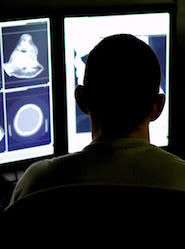The radiology department has transformed
from a unit of collaboration to one that focuses on interpretation, and in
order to regain past values, an efficient harmony between IT and humans needs
to be achieved.
As radiologists we have to be valued for not just interpreting images. I have been around the world giving talks, and I seen radiology practices where they lock the reading room door because they have so many studies to interpret and don’t want to be “disturbed” by clinicians. They’re no longer collaborating with their physician colleagues. My father, who was also a radiologist, used to say that the picture archiving and communications system (PACS) ruined radiology, because it replaced the days of richer collaboration, when radiologists understood that their job was not just interpreting a chest x-ray but collaborating and being a ‘doctor’s doctor’.
Before PACS was introduced, clinicians had to come to the radiology reading room multiple times a day and interact with radiologists. It was inefficient, but radiologists were valued as important members of the clinical team. We understood the role of managing patients, not just interpreting images. Today, reading rooms are quiet, lonely places. The dominant way we communicate is with a report, which is a woeful substitute for how it used to be. A report is like a “message in a bottle” that I throw over the wall and hope you read it. In some ways, we’ve taken a step backwards because of PACS. PACS has allowed us to be more efficient, but it has isolated us and depreciated our perceived value. We need to be valued for understanding what the role of imaging is in taking care of patients, not simply generating a report. This also demonstrates our relative immaturity in how we should best leverage IT to achieve modern-day collaboration: in order to go back to the “good old days” when we were the “doctors’ doctor,” we need to use modern IT tools. Merely relying on the phone call and the radiology report alone is not sufficient.
The reason we need technological help, whether it’s artificial intelligence (AI) or something else, is because now simple image interpretation is not enough. We have a significant increase in dataset complexity, and we have to be truly impactful in managing patients, not just interpreting images. However, our customers are becoming even more demanding, so it’s not enough just to go back to my father’s time when we collaborated more. We clearly must do that with our physician colleagues and with patients directly. However, there are drivers now that make it even more difficult to for us to be engaged beyond just interpretation. This is where I hope AI will help. Our customers demand that we go beyond simple morphological characterisation—“it’s a mass”—to more actionable, functional, physiologic quantitative interpretation, in order to predict the prognosis for what this mass might be and what needs to be done. We need to go beyond isolated interpretation of an image to multidisciplinary collaboration and synthesis.
I don’t know about other radiologists, but I barely keep up now with basic qualitative interpretation. As for demanding quantitative interpretation and much more specific phenotypic radiomic interpretation; how am I going to do that manually? It’s impossible. There is no way a human can do that accurately with efficiency and that’s why we need some advanced IT help. That's why many of us are advocates of this technology; not just AI but other human-machine optimised collaboration. The broader goal is to catch up to other business verticals and achieve better human-machine workflow cybernetic harmony to be able to do this. The other drivers are cost reduction, efficiency, quality improvement and reduction in variability—simultaneously. This will become more critical as we move from fee for service to shared risk/capitated models. There is no way you can do this without advanced IT.
Zoom On
What is your top management tip?
Use a “hedge” strategy: don’t dig for
the gold, build the shovel! At the turn of the 20th century, there was a gold
rush in California. Most people failed to find gold. Who succeeded? The people
who sold these folks the shovels. You don’t have to pick the early AI technology
winner; instead, build a truly capable IT infrastructure NOW. Not only can you feed
the AI winners, but we can also feed other advanced IT, such as big data
analytics and data mining.
What
would you single out as a career highlight?
My early wavelet algorithm work that
ultimately was commercialised via Stentor. Back then, we had PACS but we had no way to
deliver images in full fidelity on the web so that we could stop printing film
for our clinical colleagues. I am proud of our contributions in this field; we came
up with a solution that made enterprise image distribution real.
If
you had not chosen this career path you would have become a…?
When people look at my CV they see that
I went to Harvard for college and Stanford for my medical and engineering
degrees. They naturally believe that I had an interest in informatics from the
start. However, the only reason I went to Stanford is that I wanted to play
ultimate frisbee, and at that time, Stanford had the best ultimate frisbee team
in the country. And the reason I got my engineering degree was that I needed
more classroom eligibility to play in the national collegiate championship of
ultimate frisbee. My current motivation
in informatics is that I consider myself a clinician first. If someone said to
me that I could either do informatics 24/7 or take care of patients 24/7, the
answer would be a no brainer. I would be a clinician; just a plain old simple
radiologist that does interventional and abdominal imaging, because to me
that’s what drives truly useful informatics solutions.
What
are your personal interests outside of work?
My wife makes me play golf —under protest!
Image credit: U.S. Air Force photo/Senior Airman Julianne Showalterhttp://www.af.mil/News/Photos/igphoto/2000651727/
























